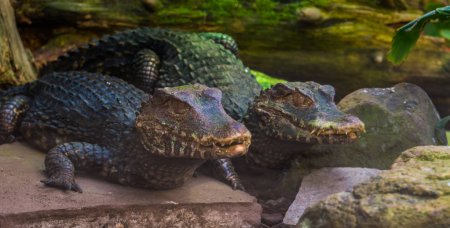ANIMAL: Cuvier’s Dwarf Caiman Paleosuchus palpebrosus Type of Animal: Crocodilian Habitat: Rivers, streams, riverine forest, flooded forest, swamps, lagoons, rapids, flooded savanna/grassland, rainforest, ponds, marshes Location(s): N. & C. South America Appearance: Smallest crocodilian species, dark brownish-black/black coloration w/ brown, somewhat pointy head, bony scales, dome shaped skull, young animals brown w/ black bands. Food/Diet: Fish, crayfish, crabs, shrimp, snails, beetles, birds, small mammals, amphibians, young caimans (including own species), crickets, spiders, aquatic insects. Status in Wild: Stable Conservation: Breeding on farms, aquariums, zoos, & wildlife parks. Farmed for meat & hide. Lifestyle: Solitary or male-female pairs Additional Info: Called: Male-Bull Female-Cow Young-Hatchling Group-Pair Weight: Male-15 lbs Female-12 lbs Young-5.28 oz Gestation: 2 months Body Length: Male-5 ft Female-4 ft Young-0.9 ft Life Span: Up to 40 years Tail Length: 1-1.5 ft Main predators of adults are jaguars, anacondas, boa constrictors, ocelots, & giant otters. Capuchins, larger caimans (including own species), & birds prey on young. Both sexes, but especially males, very territorial & fights sometimes result in death from bite wounds. Incubation period lasts 3 months. Sexes of eggs determined by incubation temperature. Sexually mature at 10 years old. Possibly declining in wild due to hunting for meat/skin, pet trade, habitat loss, & water pollution. Females lay 10-25 eggs Nests often laid next to termite mounds. While most crocodilians have yellow eyes, this species has brown eyes. Hatching usually occurs in wet season. Known to be fairly hardy creatures, they can live in nutrient-deficient waters. They’re slow breeders, breeding only every 3 years. Males roar during breeding season to ward off other males. Sometimes use burrows as shelters during daytime. Named after person who first described it-French zoologist Georges Cuvier. Also called wedgehead caiman. When threatened, they’ll inflate body to seem bigger & hiss. Fun Fact(s): One of most common crocodilian species in pet trade. However, they don’t make good pets due to temperament and somewhat larger size (even though they’re smallest crocodilians). In fact, no crocodilian makes a good pet. Despite smaller size, they’re known to be very aggressive & dangerous. Many individuals are shy, avoiding people. Sharp teeth can cause immense damage, even bite from hatchling can cause bleeding.
